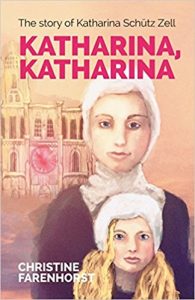Katharina Schutz, curious, talkative, and impulsive, notices everything around her: Frau Bauer, the neighbor across the street whose babies all died; the light in the studio where she learns to weave; cousin Ursula’s bitterness; the different priests; and the ever-present need to be good enough to earn favor for those who have died. And in in early 16th century Strasbourg, many do die.
Katharina’s early life revolves around her family and her church. As middle daughter in a loving woodworker’s family, she learns from her older sisters, cares for the little ones, sweeps the shop for her Vati, and runs errands for her Mutti. Dear Dr. Geisler, the priest, guides her, and as she grows up she devotes herself more and more to good deeds, becoming beloved in the neighborhood as well as among family and friends.
As Katharina grows up, Strasbourg is plastered with pamphlets from a faraway priest, brother Martin. These are widely discussed, also in the Schutz family. In fact, a new priest, Matthis Zell, is a welcome guest at the Schutz home, partly because he loves to discuss these ideas with Katharina’s father….
Katharina, Katharina is an illuminating peek into Strasbourg during the Reformation. Sometimes the historical explanations overtake the story, and the book does begin quite slowly, but the story itself is both moving and interesting. Katharina is a splendid character, full of life, zest, and eagerness to love others. At times it seemed as though she would burst out of the book and into my living room.
In an epilogue, we learn that the real Katharina became the wife of Strasbourg’s first reformer, a dynamic woman who hosted many (including Calvin) and who visited with Luther. She wrote pamphlets, promoted hospital reforms, sheltered exiled pastors, and served those in need. Christine Farenhorst did a beautiful job of portraying what the early years of such a dynamic woman could have been like.
This fictionalized biography of the early life of Katharina Schutz Zell lends itself especially well to being used as a springboard for further study. Many aspects of early 16th century Strasbourg are addressed, from family life, health, and occupations to church practices, current beliefs, Luther’s influence, and the progress of the Reformation.
The book ends with an epilogue, an extensive glossary, and an interesting bibliography, and Christine writes, “If you want to know more, there is always the future meeting in heaven.”
Katharina, Katharina would pair well with Luther by Those Who Knew Him (link to my review), a devotional novel that covers the same time and topics. Katharina, Katharina teaches what daily life was like in those days, and Luther by Those Who Knew Him emphasizes how Luther’s teaching altered thoughts and lives of people of all strata of society.
—
If you enjoyed this review, you might want to follow me on Google+ where I often mention helpful or interesting ideas, or connect with me on GoodReads where I share what I read.
Disclosure: I received a PDF of this book from the author.
This article may be linked to 52 Books in 52 Weeks, Finishing Strong , Raising Homemakers, Saturday Reviews, Booknificent Thursdays, Literacy Musings Monday, and The Book Nook.

